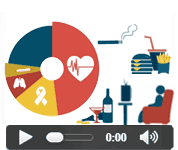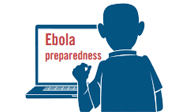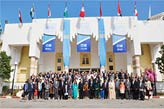Scope and Purpose
Air pollution poses risks to health even at relatively low levels, and in view of the large number of people exposed to this risk, it causes significant loss of life and ill-health in countries at all levels of development. It is strongly associated with stroke, heart and respiratory diseases and cancer, and with maternal and child health. For example one fifth of deaths from stroke and ischaemic heart disease have air pollution as the main risk factor, and IARC has recently identified air pollution as a cause of lung cancer.
In new estimates released on 25 March 2014, the World Health Organization (WHO) reports that around 7 million people, including more than 400 000 in the Eastern Mediterranean Region, died prematurely in 2012 as a result of air pollution. Detailed estimates of these deaths by country will be published by the end of 2014.
The Institute for Health Metrics and Evaluation (IHME) estimated number of deaths caused by air pollution in 2010 in 187 countries of the world. Based on these estimates, the below table summarizes the situation in our region.
|
Country |
Annual deaths |
||||||
|
Ambient PM pollution |
Household air pollution |
Ambient ozone pollution |
Radon |
Lead |
Second-hand smoke |
Occupational air pollution |
|
|
Afghanistan |
18,510 |
41,164 |
207 |
152 |
5,294 |
4,330 |
399 |
|
Bahrain |
195 |
36 |
6 |
4 |
7 |
19 |
3 |
|
Djibouti |
222 |
135 |
1 |
1 |
49 |
68 |
3 |
|
Egypt |
49,756 |
3,452 |
944 |
11 |
14,151 |
7,586 |
942 |
|
Iran |
32,288 |
1,886 |
377 |
567 |
5,804 |
1,933 |
325 |
|
Iraq |
11,787 |
1,406 |
130 |
77 |
1,892 |
2,262 |
76 |
|
Jordan |
1,638 |
114 |
35 |
22 |
154 |
247 |
16 |
|
Kuwait |
809 |
143 |
5 |
1 |
6 |
110 |
4 |
|
Lebanon |
1,807 |
37 |
27 |
37 |
206 |
445 |
18 |
|
Libya |
2,636 |
93 |
28 |
22 |
123 |
189 |
43 |
|
Morocco |
7,947 |
1,545 |
98 |
244 |
2,502 |
897 |
160 |
|
Oman |
577 |
117 |
5 |
4 |
51 |
26 |
4 |
|
Pakistan |
75,843 |
114,806 |
3,530 |
481 |
21,710 |
17,950 |
5,837 |
|
Palestine |
1,031 |
173 |
10 |
19 |
313 |
101 |
9 |
|
Qatar |
167 |
9 |
1 |
2 |
0 |
21 |
1 |
|
Saudi Arabia |
8,550 |
1,471 |
66 |
7 |
719 |
406 |
42 |
|
Somalia |
684 |
7,574 |
4 |
11 |
640 |
1,487 |
68 |
|
Sudan |
6,535 |
15,567 |
76 |
36 |
1,719 |
1,850 |
212 |
|
Syria |
7,799 |
421 |
71 |
18 |
1,964 |
993 |
918 |
|
Tunisia |
3,679 |
313 |
83 |
90 |
1,036 |
456 |
65 |
|
UAE |
1,450 |
46 |
23 |
13 |
9 |
100 |
21 |
|
Yemen |
7,392 |
7,695 |
65 |
50 |
1,774 |
1,498 |
118 |
|
|
241,302 |
198,204 |
5,794 |
1,869 |
60,120 |
42,975 |
9,284 |
The objectives of this side meeting are to: highlight the high impact of air pollution on health of most of the countries of the region; alert about the serious lack of monitoring air pollution; inform about the global platform for air quality and health which is being established by WHO, and discuss the establishment or designation of national health institutions capable of conducting research on and monitoring and reporting on health impacts from air pollution and its sources.
Importance of addressing air pollution and health
Air pollution is closely linked with several thematic areas being discussed in the context of the post-2015 development agenda, including sustainable energy, transport, cities and health. This creates an opportunity for the health sector to influence the framing of policy responses to air pollution, advocating those most favorable to public health. Air pollution health impacts also illustrate the nexus between these dimensions of sustainable development.
Excessive air pollution is often a by-product of unsustainable policies in sectors such as transport, energy, waste management and industry. In most cases, healthier strategies will also be more economical in the long term due to health-care cost savings as well as climate gains. WHO and health sectors have a unique role in translating scientific evidence on air pollution into policies that can deliver impact and improvements that will save lives.
While the health sector has already been engaged in action to address air pollution (the WHO air quality guidelines being a notable example), this engagement is not occurring in a systematic and coordinated fashion. There is a need for a more coherent and coordinated overall response that also takes into account and addresses relevant linkages with existing health priorities and concerns, including the noncommunicable disease agenda, the attainment of the health-related millennium development goals, in particular those related to maternal and child health, and the promotion of universal health coverage. Similarly linkages with other relevant objectives, such as the enactment of health in all policies, need to be articulated.
Additional obvious gains in mitigation of climate change would come through reductions in air pollution greenhouse gases and pollutants. Perhaps the largest advance is in documenting the rapidly growing evidence that well-planned actions to reduce greenhouse gas emissions can also bring very large health gains.
Challenges in the Region
A recent WHO/CEHA air pollution assessment concluded that several countries of the Region still do not have adequate regulations and/or systems for monitoring air pollution. Data from the WHO 2014 database on air pollution shows that out of the 1600 cities that are reporting PM10 data globally (particulate matter of less than 10 micrometres in diameter), only 26 cities are in the Eastern Mediterranean Region. Worldwide only 12% of the people living in cities reporting such data, reside in cities where the air quality complies with WHO air quality guideline levels, unfortunately in our Region this figure is close to 0%.
Both WHO and IHME estimates are indicating the following:
- Afghanistan, Pakistan, Somalia, Sudan and Yemen are suffering from high burden of household air pollution on health
- Afghanistan, Egypt, Iran, Iraq, Lebanon, Libya, Pakistan, Saudi Arabia, Syria and Tunisia are suffering from outdoor air pollution
- Double burden of indoor and outdoor air pollution is being witnessed in Afghanistan, and Pakistan
According to WHO Data on annual mean figures for PM10 for the six WHO regions, the highest levels of PM10 concentration are being recorded in the Region. In view of the near absence of land-based PM2.5 (particulate matter of less than 2.5 micrometres in diameter) data in the Region, data generated by computer models and satellite-derived maps provide strong evidence that almost all countries of the Region exceed the WHO guideline of annual mean of PM2.5 (10 μg/m3). It is worth mentioning that some of this pollution is natural caused by sand and dust storms. But it still is causing damage to our health. Experts and related institutions from the Region are calling upon WHO to help in supporting more research for better understanding of the impact of this natural pollution on health through addressing it in the coming version of the WHO air quality guidelines planned for 2015.
Expected outcome of the meeting
Leaders of the health sector in the Region will be aware of the serious health impacts of both outdoor and indoor air pollution, which will strengthen their capacities as advocators for motivating action by other relevant sectors.
A roadmap for addressing the health impacts of air pollution in the Eastern Mediterranean Region will be outlined. This will be the first practical step in the implementation of one of the top priorities that was identified by the Regional Environmental Health Strategy and Action Plan 2014-19 which was endorsed by the 60th session of the EM Regional Committee. This roadmap will be aiming at: Strengthening the regulatory capacity and partnership building roles of the public health sector for establishing and monitoring national air quality standards in line with WHO air quality norms; Developing/strengthening the surveillance function of the public health sector with regard to air quality; and 3- Increasing the awareness of all stakeholders (including the public) about air pollution risks.
Conclusion
Given the public health importance of air pollution, in view of the fact that action on the social, economic and environmental determinants of health is already a leadership priority in the Twelfth General Programme of Work 2014–2019, and because of the scale of the response required, both countries’ and the Secretariat’s programmatic activities in the area of air pollution and health may need to be scaled up. This includes updating, disseminating and implementing WHO guidelines on air quality and interventions to address this risk to health; monitoring, evaluating and reporting on air quality and related health impacts; strengthening the evidence base for policy action and applied research; and building capacity in the health sector to engage with other sectors and contribute to preventive action in countries.









